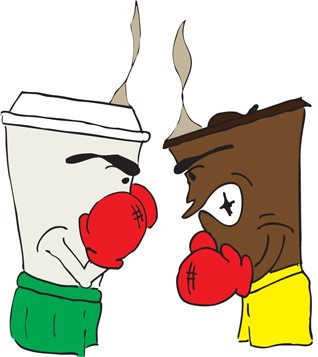$5 for a real latte, or $3 for a fake one
Starbucks backs down while Hortons invades the States, and the latte market
Canada’s favourite franchise, Tim Hortons, is stepping further into the American market this summer, opening nearly a dozen new storefronts in New York City, including one in Times Square. At the same time, Starbucks has announced huge closures and is rebranding some locations in an attempt to weather the economic downturn.
This had lead some people to question how our tastes will weather the recession – especially now that it’s giving mixed signals of abating – and to wonder what it is that draws us to coffee shops in the first place.
“Certain stocks take on a role of defense as companies scale back,” explained University of Winnipeg assistant economics professor James Townsend.
Townsend likens the situation to dining habits, where people might be eating more Kraft Dinner and eating out less.
“People may be moving away from luxury goods to basic goods [in this recession],” he said.
The new Hortons stores – which opened following the much-publicized health code violations of several Dunkin’ Donuts locations – opened as part of Tim Hortons’ American expansion campaign. The campaign already includes 500 American locations, with more popping up in Manhattan, the commercial center of the U.S.A.
In the mean time, the American icon of premium coffee, Starbucks, has announced closures of its widely expanded empire. In its hometown of Seattle, WA, it announced it’s rebranding itself as a local coffee shop, with the added bonus of liquor sales. In a press release, Starbucks calls its new location “eclectic and raw,” and advertises features like recycled Starbucks equipment. The new store tries to recreate the “European mercantile” inspiration of the original Starbucks location. It even forgoes the Starbucks name for the more anonymous 15th Ave. Coffee & Tea.
While Starbucks may be suffering in a time when sales of high-end beverages are slowing, Tim Hortons is expanding with their own low-cost versions of premium coffees.
Stating, “[New Yorkers] are prepared to try new things,” Tim Hortons president Don Schroeder seems to think that “savvy consumers” are looking for exactly what Tim Hortons offers.
Given that Hortons’ market is the coffee-and-donuts crowd and turf wars are more often against McDonalds than Starbucks, it seems the Canadian chain sees advantage in offering a new opportunity for people who can no longer break the bank on $5 lattés.
But what is it that makes a cafe appealing?
Rebecca Widdicombe, a University of Winnipeg student and coffee shop devotee, said she prefers the appealing physical space of Starbucks, rather than the “dirty and noisy” Tim Hortons.
When asked if the Canadian image of Tim Hortons is important to her, she politely said “No.”
She prefers Starbucks based on what she says is an “aesthetic issue” – the quality of coffee is of little consequence.
“I want coffee shops to resemble European coffee shops, like they do in Montreal,” she said.
The ubiquity of Starbucks is well known, which makes the new marketing technique surprising.
The press release refers to a desire to find “a deep connection to the local community,” which speaks to quite the opposite of the global brand Starbucks has built.
Some feel that Tim Hortons also maintains its local connections.
Stacey Paton, an employee at the local Fyxx Espresso Bar, thinks Tim Hortons might be appealing because of its local guise.
“[Tom Hortons] has done a really good job of promoting itself as a local coffee shop.”
“Tims feels corporate, but its part of everyday Canadiana. And it’s convenient.”
If tough economic times point to a shift in marketing and consumer demand, high stakes sales like coffee seem to be the field where the most interesting battles will be played.
Tim Hortons calls its move to New York “a major market offensive,” while Starbucks is playing defence on home ice.
Published in Volume 63, Number 30 of The Uniter (August 13, 2009)







